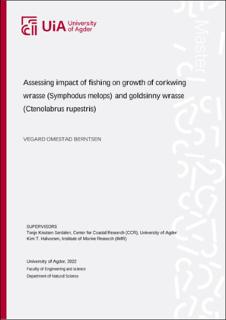| dc.description.abstract | Corkwing wrasse (Symphodus melops) and goldsinny wrasse (Ctenolabrus rupestris) are two temperate wrasse (Labridae) species that are targeted by commercial fishery due to their ability to reduce sea-lice infections. The scientific community has raised concerns regarding the long-term sustainability of the wrasse fisheries, as these two species are extensively harvested along the Norwegian coast. Studies on a wrasse fishery impact on wild populations of corkwing and goldsinny wrasse are therefore needed. Addressing whether harvesting impacts growth rate in these two species can provide a better understanding of how wild populations of wrasse are affected. Giving a better basis for future regulations and directions to maintain a sustainable wrasse fishery.
In this study, I analyzed five years of catch-mark-recapture (CMR) data on individual growth collected in a marine protected area (MPA) on the west coast of Norway. A before-after control-impact (BACI) approach on two adjacent islands (fished and control (MPA)) allowed me to assess the possible effect of a replicated wrasse fishery on growth rates in wild populations of corkwing and goldsinny wrasse. A total of 8855 of corkwing and 4993 of goldsinny were tagged over thirteen sampling periods between 2017 and 2021. In total 1890 corkwing and 733 goldsinny were recaptured. My results showed a significant difference in growth rate between fished area and control area for male corkwing wrasse. Males in the fished area had a faster growth after fishing started compared to before. This could indicate that fishing had a clear effect on male corkwing growth. In the long run, this may be a positive sign for the fished population since males growing larger quicker could lead to earlier maturation, better male parental care, and better population productivity. Female corkwing wrasse did not show significant differences in growth rate between the areas, neither before nor after fishing started. Earlier maturation could be a possible explanation, with more investment towards gonad growth instead of growth. For goldsinny there was little difference in growth between fished and control area, neither before nor after fishing started. A possible explanation could be that both sexes of goldsinny grow slower than corkwing, meaning that it could take a longer time to detect any differences in growth. Based on my results, there are reasons to believe that a wrasse fishery will have a greater impact on corkwing compared to goldsinny. As corkwing showed more difference between the two areas. Goldsinny did not have the same growth variation between the areas. This could indicate that fishing can have less negative effect than anticipated, especially if faster growing males provide better parental care. | |
